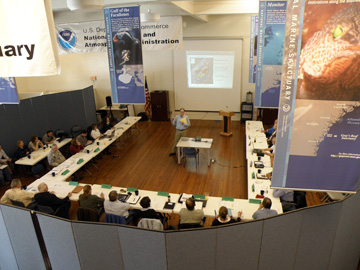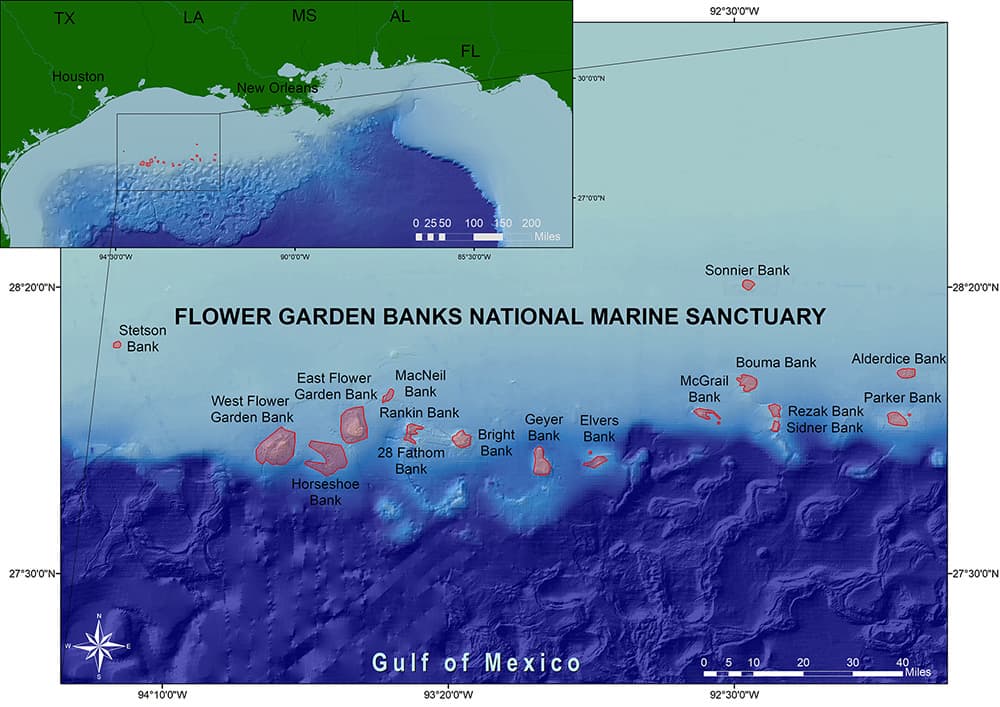2012 MANAGEMENT PLAN:
FREQUENTLY ASKED QUESTIONS

Following are answers to several questions you may have about the 2012 Management Plan, an important sanctuary document.
You may click on a link below to jump directly to a specific question, or scroll down the page to read them all.
-
-
-
-
-
-
-
-
-
-
-
-
-
-
-
-
-
top of page
What is a Management Plan?
A Management Plan is a public document that outlines management actions for the sanctuary over the next 5-10 years. It includes several action plans focused on priority issues identified through public comments, input from Sanctuary Advisory Council members, and staff discussions.
To download the actual document, please visit our 2012 Management Plan page.
top of page
What is the Sanctuary Advisory Council (SAC)?
The SAC consists of 16 voting members who represent a variety of regional interests and sanctuary stakeholders. As a group, they make recommendations to the sanctuary superintendent regarding issues important to their constituencies. Members of the Advisory Council were involved in developing and drafting action plans for the DMP.
top of page

Advisory Council meetings were an important part of the Management Plan Review process and fostered discussion on a number of key topics.
How was the 2012 Management Plan developed?
The Management Plan Review (MPR) process began in 2006 with a series of public scoping meetings and a public comment period. Information received from these was reviewed by sanctuary staff and the SAC, who worked together to identify priority issues. The SAC then formed committees to evaluate each of the issues and made recommendations to the sanctuary superintendent. From that point, sanctuary staff developed specific action plans and wrote a Draft Management Plan (DMP). The DMP was then open to public comment and additional discussion. Some of the issues raised during the public comment period were addressed through changes to the Draft Management Plan, resulting in our final 2012 Management Plan. A section of the 2012 Plan addresses the questions and comments submitted through the public comment period and any actions taken in regard to those items.
top of page
What is proposed by the 2012 Management Plan?
There are four main ideas addressed by the 2012 Management Plan:
- Actions
to be conducted by sanctuary staff in the next 5-10 years to protect and conserve marine resources in the northwestern Gulf of Mexico.
- Further study to determine the need for a scientific research area within the sanctuary to better understand the impacts of hook and line fishing and Scuba diving.
- A recommendation to expand sanctuary boundaries to include additional reefs and banks in the northwestern Gulf of Mexico.
- Minor regulatory changes.
top of page
What are the key topics addressed by the action plans?
The action plans address the following six topics: Sanctuary Expansion, Education and Outreach, Research and Monitoring, Resource Protection, Visitor Use, and Operations and Administration.
top of page
Since the original sanctuary management plan was implemented in 1992, we have discovered additional features around the sanctuary that we didn't previously know existed. We have also identified some geological and biological connections between the sanctuary's banks and other reefs and banks located in the northwestern Gulf of Mexico that may be important to the sanctuary's overall health and stability.
Note: The sanctuary expansion process resulted in the addition of 14 reefs and banks across the northwestern Gulf of Mexico

The expanded sanctuary, as of March 2021.
top of page
When the management plan was finalized, did that mean the sanctuary was automatically expanded?
No. The 2012 Management Plan simply lists sanctuary expansion as an action to pursue within the next several years. However, NOAA considers sanctuary expansion a high priority and intends to immediately investigate this option.
Note: Sanctuary expansion efforts concluded in March 2021 with the addition of 14 more reefs and banks across the northwestern Gulf of Mexico.
top of page
What additional actions are required to expand the sanctuary?
First, an Environmental Impact Statement (EIS) must be prepared concerning the areas of the Gulf of Mexico we are considering for sanctuary expansion. This must address not only the impacts on wildlife, but also on the people who use the areas in question, including socioeconomic impacts.
A very important component of the process for preparing an EIS is public involvement. During the development of the EIS, there are several opportunities for the public to learn about and comment on the proposal and the content of the EIS.
Next, the actual boundaries for these areas must be determined. Some of the information influencing boundary placement will be the location of critical habitat and existing oil and gas infrastructure. The goal is to maximize habitat protection while minimizing impacts to existing activities in the area.
Finally, regulations for the expanded areas will have to be determined. These may or may not remain the same as existing sanctuary regulations.
Note: Sanctuary expansion efforts concluded in March 2021 with the addition of 14 more reefs and banks across the northwestern Gulf of Mexico. A step by step explanation of the entire expansion process is provided on the expansion web page.
top of page
If the sanctuary is expanded, will spearfishing be prohibited in the new areas?
This has yet to be determined. Once the exact areas are identified we will have to consider which of the existing sanctuary regulations will apply, or if some modification of those regulations is needed. Spearfishing is prohibited in existing sections of the sanctuary (East and West Flower Garden Banks, Stetson Bank), but that may not be appropriate for all of the additional areas. Public input and the most current science information available will play a role in this decision.
Note: Sanctuary expansion efforts concluded in March 2021 with the addition of 14 more reefs and banks across the northwestern Gulf of Mexico. Spearfishing is prohibited in all of the new areas.
top of page

Fishing is allowed within the sanctuary with certain gear restrictions. Decisions about fishing regulations in any areas proposed for sanctuary expansion would be addressed through the expansion process.
Will the 2012 Management Plan prohibit fishing in the sanctuary?
No, the revised management plan will not prohibit fishing in the sanctuary, but it will continue to restrict fishing in the sanctuary to methods that are not damaging to the bottom environment as a whole.
However, one of the actions outlined in the management plan is to set up a study that would help us to determine the impacts that fishing and diving are having on sanctuary resources. This study may include temporary closure of some areas (research areas) within the sanctuary to use as comparison sites, but the exact nature of the study has not yet been determined.
top of page
Will the sanctuary become a Marine Protected Area (MPA)?
The sanctuary is already considered a Marine Protected Area (MPA). The confusion seems to lie in what the term MPA actually means. Some people interpret marine protected areas to mean areas closed to all human activities. Others interpret them as special areas established for conservation, but allowing specific recreation and commercial uses, much like national parks. In some circles, the term MPA has come to specifically mean a no-fishing area. This is not correct.
In reality, "marine protected area" is a term that encompasses a variety of conservation and management methods in the United States. Simply calling Flower Garden Banks National Marine Sanctuary an MPA does not change its regulations or the allowable sanctuary activities. More information on MPAs can be found on the web at https://marineprotectedareas.noaa.gov/
top of page
Why consider establishing a research area in the sanctuary?
Through the management plan review process, it was determined that we don't have very good information about the impacts that recreational divers and fishers are having on the sanctuary. A research area
was suggested as a way to gather this information, but the means of implementing this and the type of information this would provide still need to be evaluated.
top of page

A diver conducts research on the reef.
What is a research area?
The type of research area mentioned in the management plan is likely to be an area of habitat in which all human activity, except research, is prohibited. Even the research activities within the area would be kept to a minimum to allow nature to takes its course, as much as possible, without human influence. The purpose of this type of research area is to set up a comparison with similar habitat that continues to be subject to human influence, with the goal of identifying any similarities or differences between the two.
top of page
What additional actions are required to establish a research area?
An Environmental Impact Statement (EIS) must be prepared concerning the areas we would consider for temporary closure. This must address not only the impacts on wildlife, but also on the people who use the areas in question, including socioeconomic impacts. A very important component of the process for preparing an EIS is involvement of the public. During the development of the EIS, there are several opportunities for the public to learn about and comment on the proposal and the content of the EIS.
A comprehensive monitoring program would also be designed to determine the impact to fish populations and benthic communities. Details of such an experiment would be reviewed by the Gulf of Mexico Fishery Management Council during the planning stages.
top of page
What types of regulatory changes were made?
In very general terms, the revised regulations were designed to improve diver safety, minimize impacts to wildlife, and standardize pollutant discharge guidelines. These changes DO NOT include any kind of closure, or bans on hook and line fishing or diving.
top of page
Where can I find more information about the sanctuary?
This web site has a lot of information about the sanctuary, research and monitoring efforts, education and outreach activities, advisory council members and meetings, as well as important documents, photos, and videos. It is a great resource for learning more about the sanctuary.
top of page
How can I keep up to date with sanctuary news and activities?
The sanctuary has several different email lists to which people can subscribe based on their interests. Please visit our Email Lists page for more information.
top of page
Questions or comments? Email fgbmanagmentplan@noaa.gov